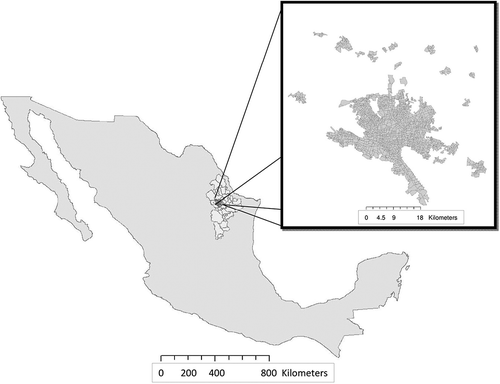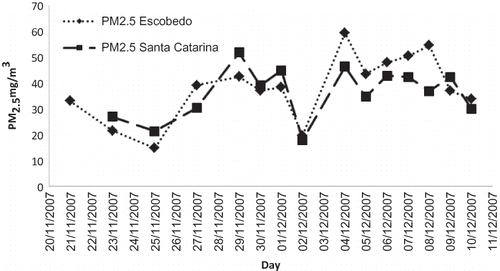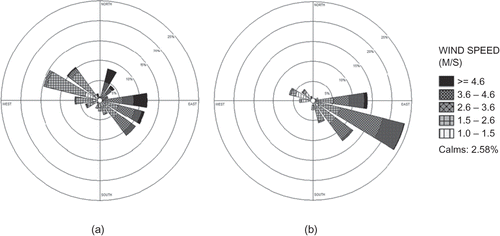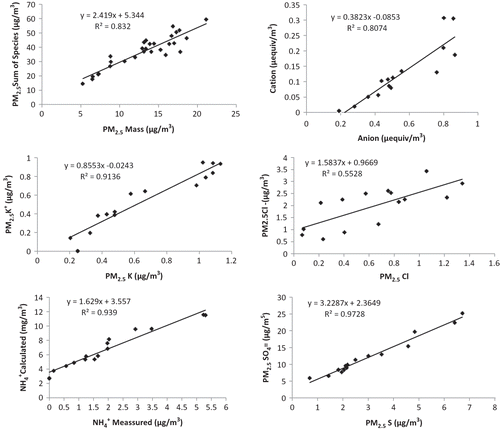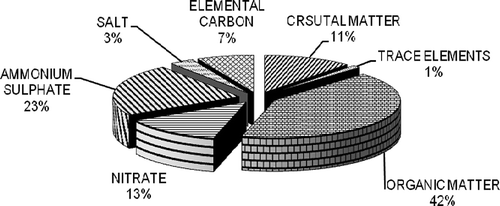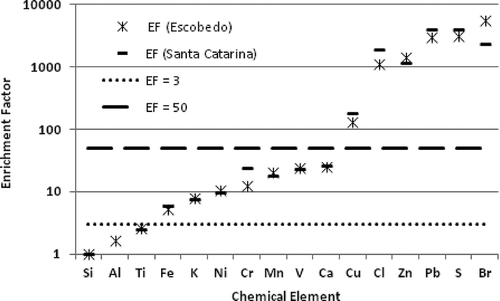Abstract
The Monterrey Metropolitan Area (MMA) has shown a high concentration of PM2.5 in its atmosphere since 2003. The contribution of possible sources of primary PM2.5 and its precursors is not known. In this paper we present the results of analyzing the chemical composition of sixty 24-hr samples of PM2.5 to determine possible sources of PM2.5 in the MMA. The samples were collected at the northeast and southeast of the MMA between November 22 and December 12, 2007, using low-volume devices. Teflon and quartz filters were used to collect the samples. The concentrations of 16 airborne trace elements were determined using x-ray fluorescence (XRF). Anions and cations were determined using ion chromatography. Organic carbon (OC) and elemental carbon (EC) were determined by thermal optical analysis. The results show that Ca had the maximum mean concentration of all elements studied, followed by S. Enrichment factors above 50 were calculated for S, Cl, Cu, Zn, Br, and Pb. This indicates that these elements may come from anthropogenic sources. Overall, the major average components of PM2.5 were OC (41.7%), SO4 2− (22.9%), EC (7.4%), crustal material (11.4%), and NO3 − (12.6%), which altogether accounted for 96% of the mass. Statistically, we did not find any difference in SO4 2− concentrations between the two sites. The fraction of secondary organic carbon was between 24% and 34%. The results of the factor analysis performed over 10 metals and OC and EC show that there are three main sources of PM2.5: crustal material and vehicle exhaust; industrial activity; and fuel oil burning. The results show that SO4 2−, OC, and crustal material are important components of PM2.5 in MMA. Further work is necessary to evaluate the proportion of secondary inorganic and organic aerosol in order to have a better understanding of the sources and precursors of aerosols in the MMA.
The MMA has become one of the most air polluted areas in Mexico. High levels of PM2.5 have been measured and effective actions need to be taken to reduce air pollution and the associated health risks. Several sources of primary PM2.5 and precursors of secondary particles exist in the MMA. This study provides valuable information for the local environmental authorities to identify possible sources of primary PM2.5 and its precursors. The effectiveness of the actions taken to improve air quality will lead to health benefits for the population, reducing their associated costs.
Introduction
Anthropogenic emissions of particulate matter (PM) and its precursors are typical in urban environments. In particular, PM with aerodynamic diameter less than 2.5 μm (PM2.5) has been widely studied due to its impact in human health, such as cardiovascular diseases and respiratory disorders (CitationDockery et al., 1993; CitationPope et al., 1995; CitationSchwartz, 1996). Ambient concentrations of PM2.5 have been related with morbidity and mortality in urban environments with annual PM2.5 concentrations in the range of 11.0 to 29.6 μg/m3 (CitationDockery et al., 1993). Airborne aerosols may contain different chemicals that come from different sources like combustion, mining and industrial activities, soil, and other sources. Due to their size, these particles remain suspended in the air and can easily be inhaled by the population exposed reaching the alveoli. The harmful effects of coarse and fine PM on the respiratory tract are well documented in the literature (CitationDockery et al., 1993; CitationO'Neil et al., 2002; CitationPope et al., 1995; CitationSchwartz, 1996).
In Mexico, the 24-hr average air quality standard for PM2.5 is 65 μg/m3 and the annual average is 15 μg/m3. High concentrations of PM2.5, well beyond these national air quality standards, have been measured in the Monterrey Metropolitan Area (MMA). The MMA is located in the State of Nuevo León, northeast of Mexico, as shown in . Since 1993 the state environmental authorities have operated the air quality monitoring system in the MMA, known as SIMA. This system started with five air quality monitoring stations, and two other monitoring stations were integrated to the system in the year 2010. The stations measure criteria pollutants and meteorological parameters. The monitoring activities for PM2.5 started at the end of 2002. The data reported in the MMA Air Quality Program show that the main pollutants are particulate matter (PM10 and PM2.5) and ozone (CitationSEMARNAT y Gobierno del Estado de N. L., 2008). In the period 2004 to 2007, the program reports that 517 days were above the PM10 24-hr air quality standard of 120 μg/m3 and 69 days were above the PM2.5 24-hr air quality standard of 65 μg/m3. It also reports that 109 days were above the ozone 1-hr air quality standard of 110 ppb in the same years. The data in the program also show that the annual PM10 air quality standard of 50 μg/m3 has been exceeded by almost 60%, while the PM2.5 air quality standard of 15 μg/m3 has been exceeded by a factor of almost 2. These data show the urgent need to adopt effective air quality policies to reduce the concentration of PM2.5 in the atmosphere of the MMA.
shows the annual concentration of PM2.5 in the five monitoring stations in the period 2003 to 2007 (CitationSIMA [Integrated System of Environmental Monitoring], 1993). The data show that the annual PM2.5 air quality standard of 15 μg/m3 has been exceeded since 2003 in all the monitoring stations in the MMA. In particular, stations NW and SW report high levels of PM2.5. This is expected, since predominant winds in the MMA are from the east and southeast (CitationSEMARNAT y Gobierno del Estado de N. L., 2008). These two stations reach annual average values around twice the Mexican annual air quality standard for PM2.5.
Table 1. Annual average PM2.5 concentration of (μg/m3) measured at five automatic monitoring stations in the MMA during 2003 to 2007
The high PM2.5 concentrations measured in the MMA represent a high health population risk due to chronic exposure. A study shows that the exposure to PM10 in the MMA may cause high health care costs (CitationVilla et al., 2008). In the case of PM2.5 the health costs have not been estimated yet. Although these costs are not known, actions need to be taken to reduce the high levels of PM2.5 concentration. Different statistical analysis techniques can provide data to determine the source of primary PM2.5 and its precursors. Among them, chemical composition of PM2.5 samples and source profiles are used to determine the source apportionment. The results of this analysis are useful to provide information for establishing cost-effective strategies to reduce airborne concentration and, consequently, health risks of the population exposed.
Several sources of primary and precursors of secondary aerosols exist in the MMA. Important sources include a refinery, quarries, chemical and metallurgical industries, construction activities, and traffic resuspension in paved and unpaved roads. The emission inventory for the year 2005 reports that mobile sources contribute 47.5% of NOx and 96.5% of CO; point sources contribute 98% of SO2 and 32.8% of NOx emissions and 13.5% of PM10 and 27.8% of PM2.5 primary emissions. Area sources contribute 68% of primary PM10 and 51% of primary PM2.5 (CitationSEMARNAT y Gobierno del Estado de N. L., 2008). The fraction of primary and secondary PM2.5 is not known in the MMA. Precursors of secondary aerosol include SO2, NOx, and organic and elemental carbon. The emission inventory reports that an oil refinery located east of the MMA contributes about 50% the total emissions of SO2 (CitationSEMARNAT y Gobierno del Estado de N. L., 2008). Other important sources of this pollutant include power plants and fuel consumption by industries in the MMA. These data indicate that SO2 may have a strong contribution to secondary inorganic aerosol. Mobile and area sources account for almost 92% of VOCs. This pollutant may have a contribution to secondary organic aerosol too. The data of the inventory show that different sources of primary PM2.5 and its precursors exist in the MMA. It is important to know the chemical composition to detect the relative importance of the different species in the PM2.5 mass concentration and their origin (primary or secondary).
The MMA is located in the northeast of Mexico. It is the third most populated metropolitan area in Mexico, with 3.5 million inhabitants. The estimated fleet is 1.7 million vehicles in 2008, and the MMA is also the center of intense industrial activities. Despite the severity of the PM2.5 air pollution problem in the MMA, there are few studies that have addressed this issue. Most of these studies have focused on PM10 and PM15 chemical composition (CitationAldape et al., 1999; CitationTRC Environmental Corporation, 1995), and few studies have addressed the impacts of PM2.5 on the health of the MMA population (CitationPeters et al., 2006). This paper provides data on the chemical composition of PM2.5 in two sites downwind of the MMA, its possible sources, and the apportionment of these sources on PM2.5 concentration levels. The methods used include statistical and multivariate analysis (factor analysis), and enrichment factor evaluation based on PM2.5 chemical composition data. The results provide valuable information on source apportionment of PM2.5 in the MMA.
Experimental Methods
Monitoring Campaign
Two sites downwind of the MMA were selected for sampling PM2.5. The sites are identified as Escobedo (ESC) and Santa Catarina (SC) and they are approximately 21 km apart. The ESC site was located in the yard of a municipal office in an area surrounded by warehouses. Near this site industrial activities are scarce and there is a highway approximately 1 km north from the sampling site. Heavy-duty and light-duty vehicles circulate on this highway because it is an alternative road that connects the eastern with the western area of the MMA, forming an arc at the north area of MMA. The SC site was located in an area of administrative offices, in an urban area surrounded by manufacturing industry and some chemical industries. These two sites frequently report the highest PM2.5 concentrations measured in the MMA by the SIMA monitoring stations. shows the location of the stations and the two sampling sites (ESC and SC). In the same figure are displayed the location of the refinery, east of the MMA, and the power plants located to the east, north, and center of the MMA.
Figure 2. Map of the MMA with the location of the sampling sites (ESC and SC), the monitoring stations, the power plants, and the oil refinery.
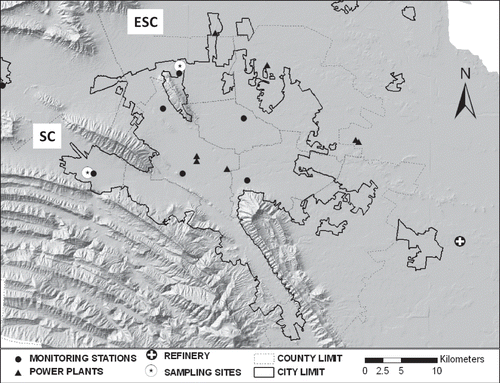
The samples were taken on different days between November 22 and December 12, 2007. We collected a total of 29 pairs of samples, 14 pairs at the SC site and 15 pairs at the ESC site. Two pairs of low-volume sampling devices by Minivol Airmetrics were used to collect 24-hr samples of PM2.5 at each site. These samplers (∼5 L/min) have been used before to address mass and chemical composition of fine PM (CitationChow et al., 2002; CitationVega et al., 2007). These samplers have shown a high level of confidence in their operation reliability. They have yielded similar concentration levels when they are located with another Minivol or other reference particulate sampler device (CitationBaldauf et al., 2001; CitationChow et al., 2008; CitationHill et al., 1999). The inlet flow was calibrated every day during the sampling period using a precalibrated digital manometer (DwyerTM).
Collection of PM2.5 Samples
Samples of PM2.5 at each site were collected using two different sets of filters. Trace elements and mass were analyzed using 47-mm Teflon filters. Anions, cations, elemental carbon (EC), and organic carbon (OC) were analized using 47-mm quartz filters. The filters were prepared and analyzed by an accredited laboratory in Tigard, OR (Chester LabNet). The filters were conditioned 48 hr at 20 ± 1°C and with a relative humidity of 30 to 40 ± 5%, according to the method of reference for gravimetric use. The field blank filters (Teflon and quartz) were conditioned under the same conditions. All quartz filters were prefired to eliminate residues that could bias the chemical analysis. The filters were analyzed and the mass of the chemicals was subtracted from those measured in the filters used for sampling. Trace elements were analyzed using x-ray fluorescence (XRF) (CitationWatson et al., 1999). Sixteen elements were detected with significant concentrations after substracting the elemental concentrations found in the blank filter. The elements quantified were Al, Si, S, Cl, K, Ca, Ti, V, Cr, Mn, Fe, Ni, Cu, Zn, Br, and Pb. Ions were analyzed by ion chromatography (IC). The anions analyzed were Cl−, nonvolatilized NO3 −, and SO4 2−. The cations analyzed were NH4 + and K+ (Na+ was dismissed after subtracting the concentration measured in the blank). Organic carbon (OC) and elemental carbon (EC) were analyzed by thermal-optical transmittance (TOT).
Enrichment Factor
The enrichment factor (EF) is used for assessing the relative contribution of chemical elements different from a typical crust composition. The EF for element i in an aerosol sample is defined by Equationeq (1):
Here, Ci is the concentration of the ith component and CSi is the concentration of Si. Hence, the enrichment factor compares the ratio between the concentrations in the environment and crustal material. Elements Al and Fe can also be used as a reference besides Si. We decided to use Si as a reference since, as commented earlier, the emission inventory of the MMA reports that most of the primary particles come from natural sources and mainly from crustal sources with high Si content. We used the relative composition from an average sample of soil given by CitationMason (1966) as a typical soil composition. This composition has been used with good results as a reference crustal composition in other studies (CitationBalasubramanian and Qian, 2004; CitationChan et al., 1997; CitationKang et al., 2004).
Statistical Analysis
Factor analysis (FA) is a multivariate statistical technique that helps to identify and quantify the impact of relevant pollution sources on the measurement (receptor) site. Factor analysis assumes that although many different parameters describing a system can be determined, such as elemental composition or particle size, there are fewer causal forces that result in the state of the system as it is observed. Factor analysis tries to identify these fewer causal forces and interpret their nature (CitationHopke, 1991). MinTab version 14 was used to perform factor analysis with Varimax rotation. This rotation maintains independence among the factors and produces a loading matrix (CitationBalasubramanian and Qian, 2004). The chemical compositions were compared to detect possible influence of upwind and local sources. The FA technique has been used in several studies related with air particulate matter (CitationAntony Chen et al., 2002; CitationMarcazzan et al., 2001; CitationWang et al., 2005).
Results
shows the measured mean PM2.5 mass concentrations of all samples, their standard deviation, and their maximum values. This table also shows the same parameters for the different elements analyzed: anions, cations, OC, and EC. We observe that the average concentration of PM2.5 is similar at both sites. Also, the concentrations of elements are similar except for Al, Cr, Br, Cl−, and K+, which show the largest differences. The concentrations of OC and EC are similar in both sites too.
Table 2. Average PM2.5 concentrations (μg/m3) ± standard deviation and maximum
shows a comparison of the PM2.5 daily concentration at the two sites during the field campaign. Due to a failure in the sampling devices, the filters of the first day at the SC site were dismissed. We observe similar values of PM2.5 concentration at both sites. The measured PM2.5 concentration at the ESC site ranges from 14.7 to 59.3 μg/m3 and at the SC site from 17.8 to 51.2 μg/m3. The PM2.5 mean concentration at ESC was 37.8 ± 12.6 μg/m3 while at SC it was 36.15 ± 9.9 μg/m3.
shows the wind roses for the sampling period prepared with data obtained from SIMA. We observe a predominant pattern of winds with high speeds coming from the east and southeast. We would expect that the samples collected would include mainly primary PM2.5 emitted from different sources east and within the MMA, as well as secondary PM2.5 formed by precursors emitted from the same locations upwind. These sources include the refinery, power plants, and chemical plants in the MMA, as well as natural sources.
Chemical Composition
We performed a correlation analysis to evaluate the quality of the data (CitationChow et al., 1996; CitationVega et al., 2004). Two field blanks were collected and their values were subtracted from the samples analyzed. As expected, the sum of individual chemical species was less or equal to the measured mass, as shown in . The same figure shows that the correlation values between cations and anions was r2 = 0.81, between soluble potassium (K+) and K was r 2 = 0.91, between chloride (Cl−) and Cl was r 2 = 0.55, between calculated NH4 + and measured NH4 + was r 2 = 0.94, and between SO4 2− and S was r 2 = 0.97. The calculated NH4 + was estimated using the equation reported by CitationZhang et al., (2002). This equation assumes that the ammonium present in particulate matter exists mainly in the form of ammonium sulfate, (NH4)2SO4, and ammonium nitrate (NH4NO3). In general, good quality of data was obtained since high correlation coefficients were found in the data validation process.
Aerosol samples were treated assuming that they are formed by seven components: crustal matter, salts, ammonium sulfate, ammonium nitrate, EC, organic matter (OM), and trace elements not included in crustal matter. This classification has been used in other studies and is based on the mass balance and typical PM2.5 sources (CitationChan et al., 1997; CitationKovouras and Koutrakis, 2001; CitationZhang et al., 2002). Ammonium nitrate and sulfate are an estimation of inorganic secondary aerosol. The concentration of ammonium nitrate is estimated as 1.29 × NO3 concentration and ammonium sulfate as 1.374 × SO4 concentration. Organic matter is obtained as 1.2 × OC concentration in order to compensate for the mass of elements like oxygen, nitrogen, and hydrogen. Some authors suggest a value of 1.4 or even 1.6 (CitationEl-Zanan et al., 2009; CitationTurpin and Lim, 2001). In this work we used a factor of 1.2 because it presented a better adjustment to the total daily mass concentrations obtained from the SIMA monitoring stations nearby the sampling sites. Crustal material was estimated as 1.89 × Al + 2.14 × Si + 1.4 × Ca + 1.43 × Fe concentrations. Trace elements were obtained adding all the elements from Na to Pb except Al, Si, Ca, Fe, Cl, K, Na, and S. Mineral salts were estimated as a function of ion Cl− affected with a factor of 1.65 (CitationVega et al., 2004).
The contributions of these components in PM2.5 mass are displayed in and . The average contributions considering all samples at both sites are displayed in . In this figure we observe that the OC contributes the highest percentage, 42%, followed by secondary inorganic aerosol with 36% (including ammonium sulfate, 23%, and ammonium nitrate, 13%). Crustal material accounts for 11% of PM2.5 mass and EC contributes 7%. Contributions from salt and trace elements were small, accounting for 3 and 1% of the measured PM2.5 mass, respectively. shows the contribution in percentage of secondary aerosol, crustal matter, elemental carbon, and organic matter for each site. As can be observed, the chemical compositions at both sites are very similar. It is important to note the small contribution of crustal matter and the high contribution of secondary aerosol and organic matter. Part of this organic matter may be secondary, as discussed in the next sections. In the case of OM, the contribution was 43% and 41%, respectively, at the ESC and SC sites, while secondary aerosol accounted for 35 and 36 %. Contributions of crustal material were 13% and 11% and EC contributed 6 and 7% of PM2.5 at the ESC and SC sites, respectively. Only salt was higher at the SC site (5%) and lower at the ESC site (1%). Trace elements accounted for 1% at each site.
Enrichment Factor (EF)
Using eq 1, we calculated enrichment factors (EF) for the different components in the PM2.5 samples. shows these factors for different elements for the ESC and SC sites. Three groups can be differentiated according to the calculated enrichment factors (CitationBiegalski et al., 1998). Elements with EF > 50 are in the first group. In this group we found S, Cl, Zn, Br, and Pb. These elements are typically related to anthropogenic sources, that is, vehicle exhaust and industries (CitationChan et al., 1997). The second group is formed by elements with EF in the range 3 to 50. This group includes K, Ca, Ti, V, Cr, Mn, Fe, and Ni. These elements can have either an anthropogenic or crustal source. The third group is formed by elements that have a crustal source and EF < 3. In this group we found Al, Si, and Ti.
Primary Organic Carbon (POC)
The EC trace method was used to estimate de primary and secondary contribution of OC in the samples collected in the MMA (CitationTurpin and Huntzicker, 1995). All the data from the two sites were used on the calculation of the primary organic carbon (POC). The method is based in the fact that EC and OC tend to have the same emission sources. Hence, it is possible to estimate a primary ratio between OC and EC for a given area. This ratio is represented by (OC/EC)p, where the subscript p stands for primary. In the case where the ambient ratio of OC/EC is greater than (OC/EC)p, the additional OC is expected to be secondary (CitationStrader et al., 1999). There are different approaches to obtaining the primary OC/EC ratio (CitationCabada et al., 2004; CitationCastro et al., 1999; CitationGray et al., Turpin and Huntzicker, 1995; CitationTurpin et al., 1991). Typically, the lowest values of the OC/EC ratio are used to estimate the POC. In this study we used the lowest 20% of ambient OC/EC values to obtain a Deming regression estimate for the POC (CitationBaumann et al., 2008; CitationCabada et al., 2004; CitationCastro et al., 1999; CitationGray et al., 1986; CitationStrader et al., 1999; CitationTurpin and Huntzicker, 1995; CitationTurpin et al., 1991). The samples taken in days where rain was present were eliminated to avoid deviations in the data analysis (CitationCabada et al., 2004). The OC values used in this study were corrected using the blank data. The POC is estimated using Equationeq (2) (CitationTurpin and Huntzicker, 1995):
The contribution of secondary organic carbon (SOC) is obtained subtracting POC to the total measured OC. In Equationeq (2), b represents the noncombustion contribution of OC to the POC and the possible contribution of sampling artifacts (CitationCabada et al., 2004).
We applied the Deming regression to the data in . The use of Deming regression has shown better results in estimating the slope and intercept when the set of data (variable x) is not a totally controlled variable (CitationTurpin and Huntzicker, 1995). The result obtained using the data of the samples is shown in Equationeq (3):
A negative value of the intercept b [−(1.07±3.13)] represents a correction of POC for other EC not associated with OC or noncombustion EC, including meat broiling operations and biogenic sources (CitationBaumann et al., 2008, CitationCabada et al., 2004). The uncertainty in the estimated value of this parameter suggests that there might be EC from noncombustion sources. Future research is necessary to obtain a more accurate value of the possible contribution of noncombustion sources on POC.
Some studies have not included the parameter b in their analysis. This would suggest that OC from sources different than combustion are ignored. In this work we estimated the percentage of SOC formation for the two cases. If b is considered in the calculation of POC, the estimated SOC average contribution in the field campaign is 34% (calculated from total OC). If b is removed and SOC is recalculated, the average contribution of SOC is 24%. Therefore, we can expect that the range of POC in OC is between 24% (minimum 16% and maximum 39%) and 34% (minimum 0% and maximum 68%). In the MMA there are not previous studies of organic aerosol formation. The impact of the noncombustion sources in the formation of SOC is unclear. From our results we can say that the average daily concentrations of SOC formation are between 3.3 μg/m3 to 4.7 μg/m3 (24% to 34% of total OC). shows a summary of the results for the lowest 20% of ambient OC/EC ratio measured from the field campaign data and the estimated OC and EC content.
Table 3. Data used for Deming regression (the lowest 20% of OC/EC values)
Factor Analysis
The factor analysis was applied to a set of 14 variables selected from the 29 samples. After applying VARIMAX rotation, three principal components with eigenvalues > 1 were selected (CitationHopke, 1991). Variables with a commonality less than 0.5 were eliminated. shows the loads after rotation. Factor 1 explains 45% of total variance. This factor groups elements from geological sources (Al and Si) and it also includes products of combustion as EC and OC. These may come from vehicle fuel combustion. Among others elements, Br and Zn have been associated with fine particles emitted in the exhaust gases of vehicles and are also included in Factor 1 (CitationKyotani and Iwatsuki, 2002). Soluble potassium is associated with biomass burning and is detected in this factor too. Factor 2 groups V, S, and SO4 −2 and explains 20.1% of total variance. Vanadium is considered a tracer of fuel oil combustion (CitationCass and McRae, 1983). Sulfur is associated with emissions from electric power plants, fuel combustion in industries, and refinery activities (CitationChu, 2005). This is consistent with the emission inventory of the MMA as it was commented before. Cl and Cr are grouped in Factor 3. This factor explains 16.4% of total variance. We consider that sea salt is not a probable source due to the distance of the ocean. Therefore, we believe that chlorine and chromium are associated with industrial activities. The enrichment factor greater than 1000 that we found for chlorine confirms this hypothesis.
Table 4. Factor analysis for trace elements, ionic species, OC, and EC in the PM2.5 samples
Discussion
As reported in the air quality program of the MMA, predominant winds in the region are from the east and southeast (CitationSEMARNAT y Gobierno del Estado de N. L., 2008). Winds coming from the southeast flow around the mountains, then change direction to the west and flow over the MMA. Being downwind, the two sampling sites capture a mixture of primary and secondary PM2.5 as a result of emissions of different sources. Thus, gases and particles emitted from a refinery, located southeast of the MMA as shown in , are transported and mixed with the emissions of power plants (located at the northeast, north, and center of the MMA), with the emissions from vehicles in the city, and with the emissions of industries located inside and surrounding the MMA. As a result, a mixture of NOx, SO2, CO, VOCs, and other pollutants forms a haze over the city with an important content of primary and secondary PM2.5, the latter formed from precursors emitted in the refinery east of the MMA and by sources within it.
Despite the high levels of PM2.5, little is known about the contribution of the different sources. Important decisions to control air pollution depend on available information about the problem. The results of this study show that the refinery and industrial, mobile, and natural sources have an important contribution in the high levels of PM2.5 found in the MMA (CitationSEMARNAT y Gobierno del Estado de N. L., 2008). The chemical data and the enrichment factor analysis show that secondary inorganic aerosol is an important component of PM2.5. Nitrates, sulfates, and organic matter are important components of the secondary aerosol. The factor analysis shows consistency of the chemicals identified and the related emission sources with influence in the MMA, as the refinery, power plants, and combustion processes. An important contribution of soil, a natural source, was identified. This material is a primary component of PM2.5 and may come from natural sources and quarries located in the MMA, as well as resuspension of dust caused by the circulation of vehicles in the city.
Based on the results of this study, we can conclude that about 40% of PM2.5 is formed by secondary species, mainly ammonium sulfate and ammonium nitrate, emitted by anthropogenic sources. Crustal matter and salt contribute 14% of total mass. The sources of these components are mainly natural and may be produced by quarries and dust resuspension by traffic. The results obtained are not totally conclusive and we cannot fully determine the source apportionment of PM2.5. However, the results presented here provide an evaluation of primary and secondary aerosol contribution in PM2.5 concentration levels in the MMA. This is the first study to estimate the contribution of different sources in PM2.5 concentration in the MMA. More studies on chemical characterization, source apportionment, and airborne dynamics are necessary to have a better understanding of the impacts of emissions. Samples of PM2.5 must be collected in other seasons to detect variations on PM2.5 chemical composition and to detect the contribution of its possible sources under different meteorological conditions in the MMA.
Conclusions
Mass concentration and chemical composition of PM2.5 were analyzed in samples taken at two sites of the Metropolitan Monterrey Area, Mexico. The samples were taken between November 22 and December 12, 2007. PM2.5 average mass concentration and its standard deviation at the ESC site were 37.8 ± 12.61 μg/m3. The maximum value measured at this site was 59.29 μg/m3. The SC site had an average and standard deviation of PM2.5 mass concentration of 36.5 ±9.88 μg/m3. The maximum value measured at this site was 51.73 μg/m3. Although the average values found were below the 24-hr air quality standard of 65 μg/m3, the annual average PM2.5 concentration calculated with data measured by the monitoring stations has been above the annual air quality standard of 15 μg/m3 the last 5 years in all the monitoring stations.
Despite the sampling sites being separated by 21 km, the PM2.5 chemical composition at both sites was similar. We found that the most abundant elements in PM2.5 mass were S, Ca, Ni, Si, K, Zn, Al, and Pb. The OC was the most abundant component and constituted 42% of the average PM2.5 mass, followed by ammonium sulfate and ammonium nitrate accounting for 36%. Crustal material constituted only 11% of the average PM2.5 mass. SOC was estimated in the range of 24% to 34% of total OC. The factor analysis supports the hypothesis that emissions from a local refinery, traffic, power plants, and industrial activities have an important contribution in the formation of secondary aerosol. Natural sources are also an important source of primary PM2.5. However, more studies are necessary to achieve more conclusive source apportionment results for PM2.5. These include understanding PM2.5 seasonal variations and composition in other sites at the MMA.
Acknowledgments
We gratefully acknowledge the scholarship of PROMEP for the development of this work, the Air Quality Research Program at ITESM for financial assistance, and the APMRN of the State of Nuevo León for assistance in the sampling sites.
References
- Aldape , F. , Flores , M.J. , Diaz , R.V. , Hernandez-Mendez , B. , Montoya , J.M. , Blanco , E.E. , Fuentes , A.F. and Torres-Martinez , L.M. 1999 . PIXE analysis of airborne particulate matter from Monterrey, México. A first survey . Nucl. Instrum. Methods Phys. Res. B: Beam Interactions with Materials and Atoms , 150 : 439 – 444 .
- Antony Chen , L.W. , Doddridge , B.G. , Dickerson , R.R. , Chow , J.C. and Henry , R.C. 2002 . Origins of fine aerosol mass in the Baltimore–Washington corridor: Implications from observation, factor analysis, and ensemble air parcel back trajectories . Atmos. Environ , 36 : 4541 – 4554 .
- Balasubramanian , R. and Qian , W.-B. 2004 . Characterization and source identification of airborne trace metals in Singapore . J. Environ. Monit , 6 : 813 – 818 .
- Baldauf , R.W. , Lane , D.D. , Marotz , G.A. and Wiener , R.W. 2001 . Performance evaluation of the portable MiniVol particulate matter sampler . Atmos. Environ. , 35 : 6087 – 6091 .
- Baumann , K. , Jayanty , R.K.M. and Flanagan , J.B. 2008 . Fine particulate matter source apportionment for the chemical speciation trends network site at Birmingham, Alabama, using positive matrix factorization . Journal of the Air & Waste Management Association , 58 : 27 – 44 . doi: 10.3155/1047–3289.58.1.27
- Biegalski , S.R. , Landsberger , S. and Hoff , R.M. 1998 . Source-receptor modeling using trace metals in aerosols collected at three rural Canadian Great Lakes sampling stations . J. Air Waste Manage. Assoc. , 48 : 227
- Cabada , J.C. , Pandis , S.N. , Subramanian , R. , Robinson , A.L. , Polidori , A. and Turpin , B. 2004 . Estimating the secondary organic aerosol contribution to PM2.5 using the EC tracer method . Aerosol Sci. Technol. , 38 : 140 – 155 .
- Cass , G.R. and McRae , G.J. 1983 . Source-receptor reconciliation routine air monitoring data for trace metals: An emission inventory assisted approach . Environ. Sci. Technol. , 17 : 128 – 139 .
- Castro , L.M. , Pio , C.A. , Harrison , R.M. and Smith , D.J.T. 1999 . Carbonaceous aerosol in urban and rural European atmospheres: Estimation of secondary organic carbon concentrations . Atmos. Environ. , 33 : 2771 – 2781 .
- Chan , Y.C. , Simpson , R.W. , McTanish , G.H. , Vowles , P.D. , Choen , D.D. and Bailey , G.M. 1997 . Characterisation of chemical species in PM2.5 and PM10 aerosols in Brisbane, Australia . Atmos. Environ. , 31 : 3773 – 3785 .
- Chow , J.C. , Doraiswamy , P. , Watson , J.G. , Chen , L.-W.A. , Ho , S.S.H. and Sodeman , D.A. 2008 . Advances in integrated and continuous measurements for particle mass and chemical composition . J. Air Waste Manage. Assoc. , 58 : 141 – 163 . doi: 10.3155/1047–3289.58.2.141
- Chow , J.C. , Watson , J.G. , Edgerton , S.A. , Vega , E. and Ortiz , E. 2002 . Spatial differences in outdoor PM10 mass and aerosol composition in Mexico City . J. Air Waste Manage. Assoc. , 52 : 423 – 434 .
- Chow , J.C. , Watson , J.G. , Lu , Z. , Lowenthal , D.H. , Frazier , C.A. , Solomon , P.A. , Thuillier , R.H. and Magliano , K. 1996 . Descriptive analysis of PM2.5 and PM10 at regionally representative locations during SJVAQS/AUSPEX . Atmos. Environ , 30 : 2079 – 2112 .
- Chu , S.-H. 2005 . Stable estimation of primary OC/EC ratios in the EC tracer method . Atmos. Environ. , 39 : 1383 – 1392 .
- Dockery , D.W. , Pope , C.A. , Xu , X. , Spengler , J.D. , Ware , J.H. , Fay , M.E. , Ferris , B.G. and Speizer , F.E. 1993 . An association between air pollution and mortality in six U.S. cities . N. Engl. J. Med. , 329 : 1743 – 1749 .
- El-Zanan , H. , Zielinska , B. , Mazzoleni , L. and Hansen , D.A. 2009 . Analytical determination of the aerosol organic mass-to-organic carbon ratio . J. Air Waste Manage. Assoc. , 59 : 58 – 69 . doi: 10.3155/1047–3289.59.1.58
- Gray , H.A. , Cass , G.R. , Huntzicker , J.J. , Heyerdahl , E.K. and Rau , J.A. 1986 . Characteristics of atmospheric organic and elemental carbon particle concentrations in Los Angeles . Environ. Sci. Technol. , 20 : 580 – 589 .
- Hill , J.S. , Patel , P.D. and Turner , J.R. Performance characterization of the MiniVol PM2.5 sampler . Proceedings of A&WMA's 92nd Annual Meeting of Air & Waste Management Association . St. Louis , MO . June 20–24 . pp. 99 – 617 .
- Hopke , P.K. 1991 . Receptor Modelling for Air Quality Management , Amsterdam : Elsevier .
- Kang , C.M. , Young , S. , Lee , H.S. , Kang , B.W. and Lee , S.K. 2004 . Atmospheric concentrations of PM2.5 trace elements in Seoul urban area of South Korea . J. Air Waste Manage. Assoc. , 54 : 432 – 439 .
- Kovouras , I.G. and Koutrakis , P. 2001 . Source apportionment of PM10 and PM2.5 in five Chilean cities using factor analysis . J. Air Waste Manage. Assoc. , 51 : 451 – 464 .
- Kyotani , T. and Iwatsuki , M. 2002 . Characterization of soluble and insoluble components in PM2.5 and PM10 fractions of airborne particulate matter in Kofu city, Japan . Atmos. Environ , 36 : 639 – 649 .
- Marcazzan , G. , Vaccaro , S. , Valli , G. and Vecchi , R. 2001 . Characterization of PM10 and PM2.5 particulate matter in the ambient air of Milan (Italy) . Atmos. Environ , 35 : 4639 – 4650 .
- Mason , B. 1966 . Principles of Geochemistry , New York, NY : John Wiley & Sons .
- O'Neil , M. , Loomis , D. , Torres-Meza , V. , Retama , A. and Gold , D. 2002 . Estimating particle exposure in Mexico City metropolitan area . J. Expos. Anal. Environ. Epidemiol. , 12 : 145 – 156 .
- Peters , A. , Veronesi , B. , Calderón-Garcidueñas , L. , Gehr , P. , Chen , L. , Geiser , M. , Reed , W. , Rothen-Rutishauser , B. , Schürch , S. and Schulz , H. 2006 . Translocation and potential neurological effects of fine and ultrafine particles a critical update . Part. Fibre Toxicol , 3 : 13
- Pope , C.A. , Thum , M.J. , Dockery , D.W. , Evans , J.S. , Speizer , F.E. and Heath , C.W. 1995 . Particulate air pollution and a predictor of mortality in a prospective study of U.S. adults . Am. J. Respir. Crti. Care Med , 151 : 669 – 674 .
- Schwartz , J. 1996 . Air pollution and hospital admissions for respiratory disease . Epidemiology , 7 : 20 – 28 .
- SEMARNAT y Gobierno del Estado de N. L . 2008 . Programa de Gestión para Mejorar la Calidad del Aire en el Área Metropolitana de Monterrey 2008–2012 , Colectivo Marcadotecnia .
- SIMA(Integrated System of Environmental Monitoring). 1993 http://www.nl.gob.mx/?P=med_amb_mej_amb_sima (http://www.nl.gob.mx/?P=med_amb_mej_amb_sima) (Accessed: September 2011 ).
- Strader , R. , Lurmann , F. and Pandis , S.N. 1999 . Evaluation of secondary organic aerosol formation in winter . Atmos. Environ. , 33 : 4849 – 4863 .
- TRC Environmental Corporation . 1995 . PM10 Characterization and Source Apportionment Study for the Monterrey Metropolitan Area , Tirad , OR : Final report prepared for The World Bank Group, TRC Project Number 18782 .
- Turpin , B.J. and Huntzicker , J.J. 1995 . Identification of secondary organic aerosol episodes and quantification of primary and secondary organic aerosol concentrations during SCAQS . Atmos. Environ , 29 : 3527 – 3544 .
- Turpin , B.J. , Huntzicker , J.J. , Larson , S.M. and Cass , G.R. 1991 . Los Angeles midday particulate carbon: Primary and secondary aerosol . Environ. Sci. Technol , 25 : 1788 – 1793 .
- Turpin , B. and Lim , H. 2001 . Species contributions to PM2.5 concentrations: Revisiting common assumptions for estimating organic mass . Aerosol Sci. Technol , 35 : 602 – 610 .
- Vega , E. , Reyes , E. , Ruiz , H. , Garcia , J. , Sanchez , G. , Martinez , G. and Gonzalez , U. 2004 . Analysis of PM2.5 and PM10 in the atmosphere of Mexico City during 2000–2002 . J. Air Waste Manage. Assoc. , 54 : 786 – 798 .
- Vega , E. , Ruiz , H. , Martinez-Villa , G. , Sosa , G. , Gonzalez-Avalos , E. , Reyes , E. and Garcia , J. 2007 . Fine and coarse particulate matter chemical characterization in a heavily industrialized city in central Mexico during winter 2003 . J. Air Waste Manage. Assoc. , 57 : 620 – 633 . doi: 10.3155/1047–3289.57.5.620
- Villa , V. , ándara , G. G , Reyna , R. and Mejía , G. Economic benefits of PM10 reduction in the MMA . Proceedings of the A&WMA's 101th Annual Conference and Exhibition . Portland , Oregon . June 24–27 .
- Wang , Y. , Zhuang , G. , Tang , A. , Yuan , H. , Sun , Y. , Chen , S. and Zheng , A. 2005 . The ion chemistry and the source of PM 2.5 aerosol in Beijing . Atmos. Environ , 39 : 3771 – 3784 .
- Watson , J.G. , Chow , J.C. and Fraizer , C.A. 1999 . “ X-ray fluorescence analysis of ambient air samples ” . In Elemental Analysis of Airborne Particles , Edited by: Creatchman , M. Vol. 1 , 344 Amsterdam : CRC .
- Zhang , X.Y. , Cao , J.J. , Li , L.M. , Arimoto , R. , Cheng , Y. , Huebert , B. and Wang , D. 2002 . Characterization of atmospheric aerosol over XiAn in the south margin of Loess Plateau, China . Atmos. Environ , 36 : 4189 – 4199 .
